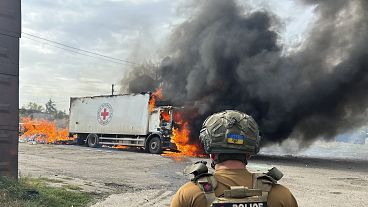Five people have died this year from the deadly West Nile virus in Spain.
Concerns are growing over the rise of West Nile virus after it killed two more people in Seville, Spain, raising the country's total to five deaths this year.
Travellers and locals alike have been advised to wear insect repellant, cover up, and avoid breeding grounds like stagnant water - particularly between dusk and dawn.
This year in Europe, cases also have been reported in Austria, Croatia, France, Greece, Hungary, Italy, Romania and Serbia. These were confirmed by the European Centre for Disease Prevention and Control (ECDC) as having been acquired locally rather than on trips to tropical regions.
It comes after dengue fever outbreaks in Europe put travellers on red alert in spring.
What is West Nile virus and what are the symptoms?
West Nile virus (WNV) can cause a fatal neurological disease in humans. It belongs to the Japanese encephalitis group of viruses, along with others like dengue and yellow fever.
Birds are the natural hosts of WNV, but it is typically spread by mosquitoes and, in a small number of cases, through blood transfusion, organ donations or pregnancy.
In around four out of five patients, WNV presents no symptoms, but in the other 20 per cent, it develops into West Nile fever. Symptoms include sudden high fever, headache, neck stiffness and a rash on the neck, arms, or legs - and in more severe cases, seizures, muscle weakness and paralysis, according to ECDC.
People over the age of 50 - especially if they have underlying health conditions - are more likely to get seriously ill. Less than 1 per cent of people go on to develop neurological infections such as meningitis or encephalitis - with one in 10 of these cases being fatal.
Symptoms typically appear two to six days after infection but can take up to 14 days or more to develop. In uncomplicated cases, these usually ease within three to six days.
How to protect yourself against West Nile virus
No vaccine against WNV is yet available for humans, so the best way to protect yourself is to prevent mosquito bites.
You can do this by not travelling to affected areas at times when mosquitoes are more common, such as in summer, and reducing your time outdoors when in an affected area.
The virus was first detected in the West Nile district of Uganda in 1937, but can now be found in countries across the world, including in Africa, the Middle East, west and central Asia, North America - and Europe.
Using mosquito repellant, covering your arms, legs and feet, and keeping mosquitoes out of your bedroom at night can also help prevent infection.
If you feel unwell - especially if you have a fever - you should contact your doctor and tell them where you have recently travelled to.
Why is Europe seeing more cases of mosquito-borne illness?
Record-high temperatures and other extreme weather events driven by climate change are causing an uptick in virus outbreaks in Europe.
“Europe is already seeing how climate change is creating more favourable conditions for invasive mosquitoes to spread into previously unaffected areas and infect more people with diseases such as dengue,” ECDC’s director Andrea Ammon said in June.
“Increased international travel from dengue-endemic countries will also increase the risk of imported cases, and inevitably also the risk of local outbreaks,” she added.
Locally acquired dengue cases in Europe almost doubled between 2022 and 2023, and figures suggest it could become even more prevalent this year.
Where are infections most likely in Europe?
Dengue-carrying tiger mosquitoes are now established in 13 European countries: Austria, Bulgaria, Croatia, France, Germany, Greece, Hungary, Italy, Malta, Portugal, Romania, Slovenia and Spain.
The first large outbreak of WNV in Europe occurred in Romania in 1996. Cases have since been identified in European countries including Austria, Croatia, France, Greece, Hungary, Italy, Portugal, Romania, Serbia and Spain.
Recently, WNV carrying mosquitos have been detected in towns near Spain's Guadalquivir River, such as Coria del Rio near Seville. Various regions in Greece have also been affected, including Kos, Thessaloniki and Zakynthos, as well as Italy including Bologna, Modena, Salerno and Venice, among others.
In 2023, 713 locally acquired cases were reported in the EU/EEA in 123 different regions - 22 of which were seeing the infection for the first time. Tragically, 67 deaths were reported.
The case seen in Spain in March this year came unusually early, likely due to unseasonably warm weather.
ECDC warns that the mosquito responsible for transmitting dengue and Zika virus is spreading further north, east and west in Europe, and has recently established itself in Cyprus.
















